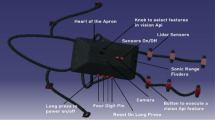Abstract
Blindness is one of the serious problems that is affecting the vast majority of people globally. Traditionally, the affected ones use white cane or a dog to assist them. However, they still have a lot of disadvantages. So, the aim of this paper is to develop a system to assist visually impaired people which acts as a navigation and obstacle/object recognition system. The system discussed in this paper is a hybrid guidance system that uses traditional stick and sensors (camera and ultrasonic) for coping in indoor and outdoor environments. The user is assisted without any human guidance by using a design with sensors and auditory feedback.








Similar content being viewed by others
References
Islam MM, et al. Developing walking assistants for visually impaired people: a review. IEEE Sens J. 2019;19(8):2814–28.
Shovel AS, Ulrich I, Borenstien J. NavBelt and the guide cane. IEEE Trans Robot Autom. 2003;10(1):9–20.
Yuan D, Manduchi R. Dynamic environment exploration using a virtual white cane. In: 2005 IEEE computer society conference on computer vision and pattern recognition (CVPR’05), 2005, vol. 1, p. 243–9. https://doi.org/10.1109/CVPR.2005.136.
Bolgiano D, Meeks E. A laser cane for the blind. IEEE J Quantum Electron. 1967;3(6):268. https://doi.org/10.1109/JQE.1967.1074528.
Sabarish S. Navigation tool for visually challenged using microcontroller. Int J Eng Adv Technol (IJEAT). 2013;2(4):139–43.
Sharma P, Shimi SL, Chatterji S. A review on obstacle detection and vision. Int J Sci Res Technol. 2015;4(1):1–11.
Cardillo E, et al. An electromagnetic sensor prototype to assist visually impaired and blind people in autonomous walking. IEEE Sens J. 2018;18(6):2568–76. https://doi.org/10.1109/JSEN.2018.2795046.
Kwiatkowski P, Jaeschke T, Starke D, Piotrowsky L, Deis H, Pohl N. A concept study for a radar-based navigation device with sector scan antenna for visually impaired people. In: 2017 first IEEE MTT-S international microwave bio conference (IMBIOC), 2017, p. 1–4. https://doi.org/10.1109/IMBIOC.2017.7965796.
Patil K, Jawadwala Q, Shu FC. Design and construction of electronic aid for visually impaired people. IEEE Trans Hum Mach Syst. 2018;48(2):172–82. https://doi.org/10.1109/THMS.2018.2799588.
Bai J, Lian S, Liu Z, Wang K, Liu D. Virtual-blind-road following-based wear-able navigation device for blind people. IEEE Trans. 2018;64:136–43.
Kaushalya VSS, et al. “AKSHI”: automated help aid for visually impaired people using obstacle detection and GPS technology. Int J Sci Res Publ. 2016;6(11):110.
Bhatlawande S, Mahadevappa M, Mukherjee J, Biswas M, Das D, Gupta S. De-sign, development, and clinical evaluation of the electronic mobility cane for vision rehabilitation. IEEE Trans Neural Syst Rehabil Eng. 2014;22:1148–59.
Zhou D, Yang Y, Yan H. A smart virtual eye mobile system for the visually impaired. IEEE Potentials. 2016;35:13–20.
Aladren A, Lopez-Nicol’as G, Puig L, Guerrero JJ. Navigation assistance for the visually impaired using RGB-D sensor with range expansion. IEEE Syst J. 2016;10:922–32.
Yang K, Wang K, Bergasa LM, Romera E, Hu W, Sun D, Sun J, Cheng R, Chen T, López E. Unifying terrain awareness for the visually impaired through real-time semantic segmentation. Sensors. 2018;18:1506. https://doi.org/10.3390/s18051506.
Mekhalfi ML, et al. Recovering the sight to blind people in indoor environments with smart technologies. Expert Syst Appl. 2016;46:129–38.
Cheraghi SA, Namboodiri V, Walker L. GuideBeacon: beacon-based indoor wayfinding for the blind, visually impaired, and disoriented. In: 2017 IEEE international conference on pervasive computing and communications (PerCom). IEEE; 2017.
Ţepelea L, Gavriluţ I, Gacsádi A. Smartphone application to assist visually impaired people. In: 2017 14th international conference on engineering of modern electric systems (EMES), 2017, p. 228–31. https://doi.org/10.1109/EMES.2017.7980421.
Author information
Authors and Affiliations
Corresponding author
Ethics declarations
Conflict of interest
The authors declare that they have no conflict of interest.
Additional information
Publisher's Note
Springer Nature remains neutral with regard to jurisdictional claims in published maps and institutional affiliations.
This article is part of the topical collection “Data Science and Communication” guest-edited by Kamesh Namudri, Naveen Chilamkurti, Sushma S J and S. Padmashree.
Rights and permissions
About this article
Cite this article
Siriboyina, L.P., Thadikemalla, V.S.G. A Hybrid System to Assist Visually Impaired People. SN COMPUT. SCI. 2, 333 (2021). https://doi.org/10.1007/s42979-021-00703-8
Received:
Accepted:
Published:
DOI: https://doi.org/10.1007/s42979-021-00703-8




